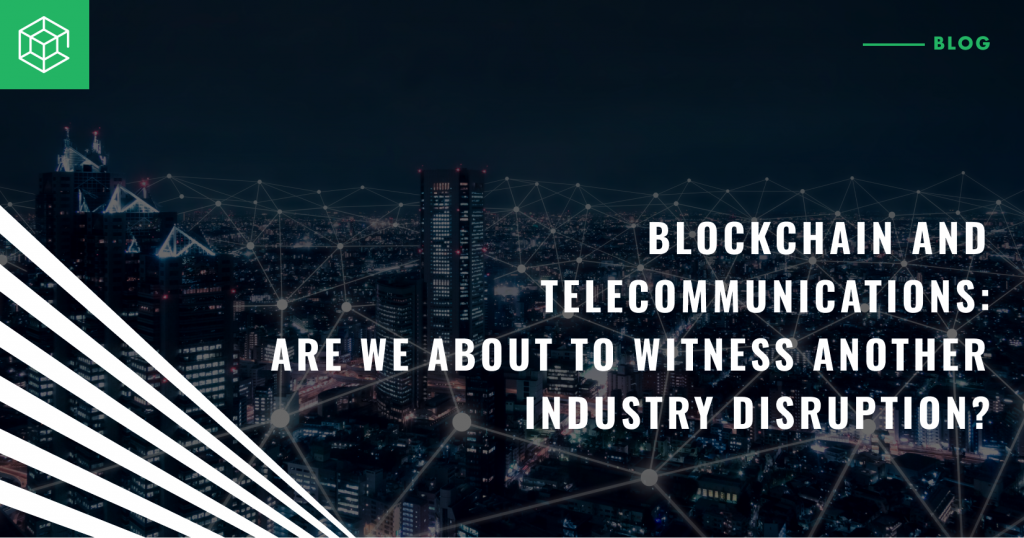Blockchain and Telecommunications: are we about to witness another industry disruption?

The telecommunications industry has been around for decades and has grown into a massive global network with dozens of providers, hundreds of base stations, billions of users and miles of wired and wireless connection routes. But what if this broad infrastructure could be used together with another, a much younger one – blockchain? A network on top of a network?
In fact, this idea has been in the air for some time, and there are already even practical implementations of blockchain solutions in telecommunications.
Customer-to-customer money transfers
Using blockchain, telecom companies can set up systems of direct money transfers between their subscribers. Blockchain has already proven its security and efficiency as a network supporting cryptocurrency transactions, and now this technology can be integrated with the existing telecom networks.
The advantage of such a solution is in its speed and cost-effectiveness. Blockchain-assisted transfers require no banks or other financial institutions to act as men-in-the-middle slowing down the processing and increasing the cost. Telecom subscribers can send money to each other right within their existing network. The money-transfer opportunities that blockchain presents to telecom companies are the subject of the research by CBSG Consortium working on developing blockchain solutions designed to revolutionize the telecommunications industry.
5G
5G is the long-awaited standard of mobile communication that promises to take it to a totally new level. 5G enables communication near to real-time allowing IoT and other implementations that are not possible today.
Physically, a 5G network consists of a large number of base stations as opposed to the current solutions where base stations are large, powerful and far apart. In fact, 5G is a decentralized network of multiple small nodes. We can say the same about blockchain, can’t we?
5G networks can be used to host blockchain equipment creating a sort of super-computer capable of solving complex tasks. Blockchain will use the existing 5G infrastructure adding its services to the 5G provider package.
Telecom tokenization
The telecommunication industry has more than one tokenization opportunity.
Unused data trading
Data is an asset, too. Telecom subscribers purchase a number of call minutes or traffic gigabytes that they often do not use up. With tokenization, this unused data will no longer be wasted.
On a blockchain-based data marketplace, users can trade their surplus gigabytes to receive, for example, data packages in another region. In other words, you can travel and communicate without the roaming charges – you will only need to trade your unused data for then at your destination.
Tokenization of telecom resources
Not only users can trade their assets – telecom providers can do it, too. They can tokenize their hardware and the coverage they produce to extend it to regions where they had minimal or no service before.
Such solutions will be a win-win for both the providers and their customers. The providers will get new markets and improved service while the customers will get higher service quality and reliable communication.
Tokenization of customer resources
And, finally, customers can even tokenize their devices to allow telecom companies to use them as network nodes. In such cases, the network costs will drop dramatically resulting in communication becoming literally free for the customers. Well, not completely free, as they are still going to maintain their devices, but the expected level of costs will be significantly lower.
Identity verification
Telecom companies hold a fair amount of users’ personal data and thus can act as identity validators for many purposes. In such applications, users can verify their personal data – name, age, address, and so on – without disclosing it to the requesting entity.
When identity verification is required, the requestor applies to the service provider – the telecom company, in our case – to check the user’s personal data in its database. The telecom company performs the check and responds that the data is either OK or not. This way, the users never need to provide their details to each service they interact; instead, they provide them only once to their trusted provider.
Blockchain can make these processes fast and error-free. There are already attempts at practical implementation of such identity verification technology.
Service billing and fraud prevention
Blockchain can make telecom billing more transparent and efficient. It can protect the providers from roaming frauds that cost telecom companies about $38 billion per year. The most common case is subscribers using roaming services for which the provider is unable to charge them. The fraud detection takes a long time after which the subscriber cannot be reached anymore.
With blockchain, the mobile device is connected to the user’s identity verified with a public key. Roaming services are provided in a permissioned blockchain network that exists between the providers having a roaming agreement. Whenever a user accesses roaming services, a contract is executed.
Blockchain can become a powerful addition to the existing telecommunication services organically integrating with their infrastructure. The benefits for telecom networks are obvious, and we are sure that we will see some bold and creative solutions in this area in the nearest future.
